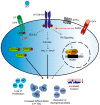Persistent Human KIT Receptor Signaling Disposes Murine Placenta to Premature Differentiation Resulting in Severely Disrupted Placental Structure and Functionality
- PMID: 32752102
- PMCID: PMC7432075
- DOI: 10.3390/ijms21155503
Persistent Human KIT Receptor Signaling Disposes Murine Placenta to Premature Differentiation Resulting in Severely Disrupted Placental Structure and Functionality
Abstract
Activating mutations in the human KIT receptor is known to drive severe hematopoietic disorders and tumor formation spanning various entities. The most common mutation is the substitution of aspartic acid at position 816 to valine (D816V), rendering the receptor constitutively active independent of ligand binding. As the role of the KIT receptor in placental signaling cascades is poorly understood, we analyzed the impact of KITD816V expression on placental development using a humanized mouse model. Placentas from KITD816V animals present with a grossly changed morphology, displaying a reduction in labyrinth and spongiotrophoblast layer and an increase in the Parietal Trophoblast Giant Cell (P-TGC) layer. Elevated differentiation to P-TGCs was accompanied with reduced differentiation to other Trophoblast Giant Cell (TGC) subtypes and by severe decrease in proliferation. The embryos display growth retardation and die in utero. KITD816V-trophoblast stem cells (TSC) differentiate much faster compared to wild type (WT) controls. In undifferentiated KITD816V-TSCs, levels of Phosphorylated Extracellular-signal Regulated Kinase (P-ERK) and Phosphorylated Protein Kinase B (P-AKT) are comparable to wildtype cultures differentiating for 3-6 days. Accordingly, P-TGC markers Placental Lactogen 1 (PL1) and Proliferin (PLF) are upregulated as well. The results reveal that KIT signaling orchestrates the fine-tuned differentiation of the placenta, with special emphasis on P-TGC differentiation. Appropriate control of KIT receptor action is therefore essential for placental development and nourishment of the embryo.
Keywords: KIT receptor; KITD816V; embryonic growth retardation; invasion; placental development; premature differentiation; spongiotrophoblast; trophoblast giant cell; trophoblast stem cell.
Conflict of interest statement
The authors declare no conflict of interest.
Figures






Similar articles
-
Diverse subtypes and developmental origins of trophoblast giant cells in the mouse placenta.Dev Biol. 2007 Apr 15;304(2):567-78. doi: 10.1016/j.ydbio.2007.01.009. Epub 2007 Jan 10. Dev Biol. 2007. PMID: 17289015
-
Hectd1 is required for development of the junctional zone of the placenta.Dev Biol. 2014 Aug 15;392(2):368-80. doi: 10.1016/j.ydbio.2014.05.007. Epub 2014 May 20. Dev Biol. 2014. PMID: 24855001 Free PMC article.
-
PTHrP promotes murine secondary trophoblast giant cell differentiation through induction of endocycle, upregulation of giant-cell-promoting transcription factors and suppression of other trophoblast cell types.Differentiation. 2005 Apr;73(4):154-74. doi: 10.1111/j.1432-0436.2005.00013.x. Differentiation. 2005. PMID: 15901283
-
Development and function of trophoblast giant cells in the rodent placenta.Int J Dev Biol. 2010;54(2-3):341-54. doi: 10.1387/ijdb.082768dh. Int J Dev Biol. 2010. PMID: 19876834 Review.
-
Genes and signals regulating murine trophoblast cell development.Mech Dev. 2010 Jan-Feb;127(1-2):1-20. doi: 10.1016/j.mod.2009.09.004. Epub 2009 Sep 13. Mech Dev. 2010. PMID: 19755154 Free PMC article. Review.
Cited by
-
Genome-Wide Association Analysis Identified Variants Associated with Body Measurement and Reproduction Traits in Shaziling Pigs.Genes (Basel). 2023 Feb 18;14(2):522. doi: 10.3390/genes14020522. Genes (Basel). 2023. PMID: 36833449 Free PMC article.
References
MeSH terms
Substances
Grants and funding
LinkOut - more resources
Full Text Sources
Research Materials
Miscellaneous

